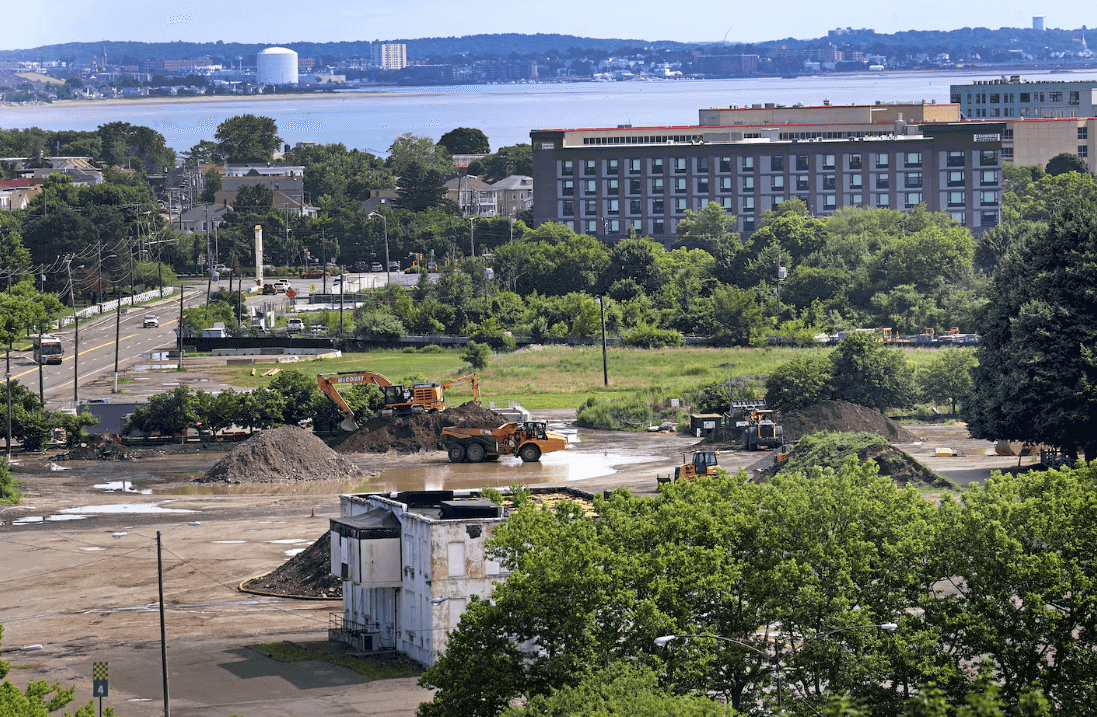马萨诸塞州未来十年必须建造 222,000 套新房来解决住房短缺问题

【中美创新时报2025 年 2 月 7 日编译讯】(记者温友平编译)希利政府周四制定了新的住房建设目标,该目标体现了马萨诸塞州面临的巨大挑战:仅未来 10 年就将建造近 25 万套新房。要达到这一目标,就意味着要加快近年来放缓的建设步伐。《波士顿环球报》记者安德鲁·布林克对此作了下述报道。
在一个因施工延误和反对各种新住房而臭名昭著的州,州长莫拉·希利任命的一个委员会的分析表明了马萨诸塞州住房短缺的严重性,这种短缺正在扭曲普通人的生活,如果该州不开始加快建设速度,情况可能会恶化。
这也给多年来一直存在的问题增添了新的紧迫感:马萨诸塞州远远落后于实现其新目标(到 2035 年建成 22 万套新房)所需的速度。尽管该州在 2010 年至 2020 年期间平均每年建造 19,000 套住宅,但此后速度明显放缓:2023 年仅发放了 11,600 套新房许可。
新的官方住房目标比前州长查理·贝克 (Charlie Baker) 设定的目标更为雄心勃勃,但实现这一目标并不容易。利率和土地和材料成本等其他金融阻力使得公寓建设融资比以往任何时候都更加困难,而各市政府正在努力使在其境内建造变得更加容易。
“我们面临的成本挑战的根源是住房短缺,”希利在周四宣布住房目标的活动中表示。“正是这种短缺……多年来,我们州一直没有建造与经济增长同步的住房,因此我们不得不建造更多住房。”
“建造这些住房单元将帮助我们降低成本,保持经济竞争力。”
但官员和倡导者周四表示,住房短缺可能会带来毁灭性的后果。目前,将收入的 30% 以上用于住房的租房者比例正在增加。马萨诸塞州的无家可归者人数也在激增。
222,000 这个数字是由 Healey 新成立的住房咨询委员会(包括民选官员、开发商和经济适用房倡导者)作为综合州住房计划的一部分制定的。它基于人口估计,其中包括首次寻找住房的年轻人和未来十年搬到这里的人新组建的家庭的预测。
该委员会与麻省大学唐纳休研究所、大都会区规划委员会和戴恩研究所的研究人员一起,在计算预测时假设未来十年人口增长适中。但即使该州的人口保持不变,马萨诸塞州仍需要在此期间建造约 73,000 套房屋,以满足现有需求以及新成立的 Z 世代和千禧一代家庭。
该报告还指出了该州最需要住房的地方:马萨诸塞州东部,包括梅里马克山谷的大量需求。
生产目标扩大了贝克设定的更温和的目标,贝克在 2017 年呼吁该州在八年内建造 135,000 套房屋。
与此同时,其他团体此前曾估计马萨诸塞州,特别是该州东部对新房的需求甚至更大。 大都会市长联盟包括来自波士顿地区的社区负责人,该联盟在 2018 年设定了一个目标,即到 2030 年仅在他们的社区就建造 185,000 套新房。
咨询委员会在周四的报告中表示,如果该州能够达到希利政府的目标,它将减轻住房市场的压力。但它并不能完全解决住房问题。报告发现,公共住房综合体中数千套公寓因失修而面临风险,而许多其他住宅也因气候变化而面临越来越大的洪水风险。
委员会没有将低收入家庭负担得起的单元纳入其生产目标。这些房屋的需求也很大。
住房倡导者一直在等待希利政府发布新的生产目标。他们说,这些目标是衡量住房短缺的重要指标,也是指导改革努力的基准,这些改革努力将加快全州的建设速度。
“老实说,如果不对政策和住房资金进行重大改变,我们很难想象如何实现 [2035 年建成 222,000 套住房] 的目标,”MAPC 执行董事 Marc Draisen 表示。“如果我们按照去年的速度生产,我们将远远达不到目标。”这是一个宏伟的目标,需要我们认真审视,并可能做出一些对某些人而言痛苦的重大政策选择。”
虽然该报告没有包括任何具体的新提案,但它提供了有关该州可能采取的提高产量的策略的见解。
《马萨诸塞州湾交通管理局社区法案》要求马萨诸塞州湾交通管理局服务的 177 个城市和城镇放宽分区规则,以便更容易建造多户住宅,该法案使得波士顿以外的社区能够进行急需的新建筑。但委员会认为,该州必须更积极地推行马萨诸塞州湾交通管理局社区以外的分区和其他监管改革。
事实上,一些社区仍在反抗该法律,这种反对将成为希利政府想要刺激的住房增长的障碍。
该报告称,该州还应贯彻希利政府的推动,确定和重新开发未充分利用的国有财产(例如马萨诸塞州湾交通管理局拥有的财产),将其改造成住房。州政府已确定了大约 100 个地点,可能适合在未来五年内开发约 10,000 套住房。
州政府应投入更多资源来保护现有的经济适用房,并简化修复日益恶化的州公共住房组合的工作。
希利去年成立的另一个委员会旨在研究增加住房生产的策略,该委员会预计很快将发布另一份报告,其中包含更具体的政策建议。
经济适用房组织 Way Finders 的首席执行官 Keith Fairey 表示,正在进行的努力只是创建和保护 222,000 套住房的起点。“在这方面,我认为该计划是对我们所有人的行动号召。
题图:波士顿-里维尔边境的萨福克唐斯开发区。David L. Ryan/环球报工作人员
附原英文报道:
222,000 new homes must be built over the next decade to fix housing shortage, state says
Hitting the target would mean picking up the pace of construction, which has slowed in recent years
By Andrew Brinker Globe Staff,Updated February 6, 2025
The Suffolk Downs development site on the Boston-Revere border. David L. Ryan/Globe Staff
The Healey administration on Thursday laid out a new goal for housing construction that captured the staggering scale of the challenge facing Massachusetts: nearly a quarter-million new homes in just the next 10 years.
In a state infamous for construction delays and opposition to new housing of all kinds, the analysis from a committee appointed by Governor Maura Healey crystallizes the severity of the housing shortage in Massachusetts that is warping the lives of everyday people and could worsen if the state does not begin building faster.
It also adds a new sense of urgency to a problem that has persisted for years: Massachusetts is well behind the pace needed to meet its new goal, 220,000 new homes, by 2035. While the state built an average of 19,000 residences a year between 2010 and 2020, the pace has since slowed markedly: Only 11,600 permits for new homes were issued in 2023.
The new official housing goal is more ambitious than that set by former governor Charlie Baker, but getting there will not be easy. Interest rates and other financial headwinds like the cost of land and materials have made it more difficult than ever to finance construction of apartments, and municipalities are fighting efforts to make it easier to build within their borders.
“At the root of our challenge with costs is a shortage of homes,” Healey said at an event announcing the housing goals Thursday. “It’s a shortage that . . . has built up over many years as our state was not building the housing that we needed to keep pace with our economic growth.”
“Building these housing units [is] going to help us bring down costs, and keep our economy competitive.”
But falling short could be devastating, officials and advocates said Thursday. Already, the share of renters who pay more than 30 percent of their income for housing is increasing. And homelessness in Massachusetts is surging as well.
The 222,000 figure was developed by Healey’s newly formed Housing Advisory Committee — which includes elected officials, developers, and affordable housing advocates — as part of a comprehensive state housing plan. It is based on population estimates that include projections of newly formed households by younger people who will seek homes for the first time, and people who move here over the next decade.
The committee, along with researchers at the UMass Donahue Institute, the Metropolitan Area Planning Council, and Dain Research, assumed modest population growth over the next decade when calculating the projection. But even if the state’s population remains flat, Massachusetts would still need to build some 73,000 homes over that period to account for existing demand and newly formed Gen Z and millennial households.
The report also identified where in the state housing is most needed: Eastern Massachusetts, including significant demand in the Merrimack Valley.
The production target expands on a more modest goal set by Baker, who in 2017 called on the state to build 135,000 homes over an eight year span.
Other groups, meanwhile, have previously estimated the demand for new homes in Massachusetts, specifically the eastern part of the state, to be even greater. The Metro Mayor’s Coalition, which includes heads of communities from the immediate Boston area, established a target in 2018 of 185,000 new units in their communities alone by 2030.
If the state were to hit the Healey administration’s target, it would ease pressure on the housing market, the advisory committee said in its report Thursday. But it would not solve the housing problem altogether. Thousands of apartments in public housing complexes are at risk due to disrepair, while many other residences are at growing risk of flooding due to climate change, the report found.
And the committee did not factor in units that are affordable for lower-income households into its production target. There is significant demand for those homes as well.
Housing advocates have been waiting for the Healey administration to issue a new production target. Those goals, they say, are an important measure of the housing shortage, and a benchmark to guide reform efforts that will speed construction statewide.
“Its honestly hard to see how we can attain [222,000 units by 2035] without major changes in both policy and the amount of funding we’re dedicating to housing,“ said Marc Draisen, executive director of MAPC. ”If we produce at the rate we did last year, we’ll fall very far short. It’s a big goal, and it’s going to require taking a hard look in the mirror, and probably making some big policy choices that are painful for some folks.”
While the report didn’t include any specific new proposals, it provided insight into strategies the state may pursue to increase production.
The MBTA Communities Act — which requires the 177 cities and towns served by the T loosen their zoning rules to make it easier to build multifamily housing — has enabled much-needed new construction in communities outside of Boston. But the commission argued that the state must more aggressively pursue zoning and other regulatory reforms beyond MBTA Communities.
Indeed, some communities are still rebelling against the law, and that kind of opposition will be a barrier to the housing growth the Healey administration wants to stimulate.
The state should also follow through on a push from the Healey administration to identify and redevelop underutilized state-owned properties, such as those owned by the MBTA, into housing, the report said. The state has identified roughly 100 sites that could be suitable for the development of some 10,000 units over the next five years.
And it should dedicate more resources to the preservation of existing affordable housing and streamline efforts to repair the deteriorating state public housing portfolio.
Another report from a separate commission Healey created last year to study strategies to enable increased housing production is expected soon, with more specific policy recommendations.
The efforts underway are only a starting point in creating and preserving 222,000 homes, said Keith Fairey, CEO of the affordable housing group Way Finders. “In that regard, I see the plan as a call to action for all of us.”

